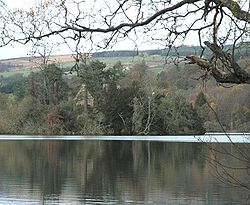
Clunie
Encyclopedia

Perthshire
Perthshire, officially the County of Perth , is a registration county in central Scotland. It extends from Strathmore in the east, to the Pass of Drumochter in the north, Rannoch Moor and Ben Lui in the west, and Aberfoyle in the south...
, Scotland
Scotland
Scotland is a country that is part of the United Kingdom. Occupying the northern third of the island of Great Britain, it shares a border with England to the south and is bounded by the North Sea to the east, the Atlantic Ocean to the north and west, and the North Channel and Irish Sea to the...
, 7 km west of Blairgowrie
Blairgowrie and Rattray
Blairgowrie and Rattray and Raitear is possibly from an English language cognate of Gaelic ràth, meaning fortress + a Pictish term cognate with Welsh tref, meaning settlement) is a twin burgh in Perth and Kinross, Scotland. Amongst locals, the town is colloquially known simply as "Blair"...
. It lies on the western shore of the Loch of Clunie. Near the village are the foundations of what is believed to have been be a castle used by Kenneth MacAlpin
Kenneth I of Scotland
Cináed mac Ailpín , commonly Anglicised as Kenneth MacAlpin and known in most modern regnal lists as Kenneth I was king of the Picts and, according to national myth, first king of Scots, earning him the posthumous nickname of An Ferbasach, "The Conqueror"...
, the first king of Scotland, as a base for hunting in the nearby royal forest of Clunie.
On a small island (formerly a crannog
Crannog
A crannog is typically a partially or entirely artificial island, usually built in lakes, rivers and estuarine waters of Scotland and Ireland. Crannogs were used as dwellings over five millennia from the European Neolithic Period, to as late as the 17th/early 18th century although in Scotland,...
) in the loch stand the remains of Clunie Castle, a tower house of the Bishops of Dunkeld
Bishop of Dunkeld
The Bishop of Dunkeld is the ecclesiastical head of the Diocese of Dunkeld, one of the largest and more important of Scotland's 13 medieval bishoprics, whose first recorded bishop is an early 12th century cleric named Cormac...
. The last pre-Reformation
Protestant Reformation
The Protestant Reformation was a 16th-century split within Western Christianity initiated by Martin Luther, John Calvin and other early Protestants. The efforts of the self-described "reformers", who objected to the doctrines, rituals and ecclesiastical structure of the Roman Catholic Church, led...
bishop, Robert Crichton, passed the property to his near relative, Robert Crichton, Lord Advocate
Lord Advocate
Her Majesty's Advocate , known as the Lord Advocate , is the chief legal officer of the Scottish Government and the Crown in Scotland for both civil and criminal matters that fall within the devolved powers of the Scottish Parliament...
of Scotland. His son James, the notable Scottish polymath
Polymath
A polymath is a person whose expertise spans a significant number of different subject areas. In less formal terms, a polymath may simply be someone who is very knowledgeable...
better known as the Admirable Crichton
James Crichton
James Crichton, known as the Admirable Crichton , was a Scottish polymath noted for his extraordinary accomplishments in languages, the arts, and sciences before his killing when aged 21.-Life:...
, spent his childhood there.
Within the grounds of the parish church, rebuilt in 1840, stands a mausoleum
Mausoleum
A mausoleum is an external free-standing building constructed as a monument enclosing the interment space or burial chamber of a deceased person or persons. A monument without the interment is a cenotaph. A mausoleum may be considered a type of tomb or the tomb may be considered to be within the...
with a romanesque
Romanesque architecture
Romanesque architecture is an architectural style of Medieval Europe characterised by semi-circular arches. There is no consensus for the beginning date of the Romanesque architecture, with proposals ranging from the 6th to the 10th century. It developed in the 12th century into the Gothic style,...
doorway thought to be from an earlier 12th or 13th century church which stood on the same site. The church is now linked with those at Kinclaven and Caputh.
Clunie Primary School is now closed but the local hall survives with regular functions taking place.
External links
- Clunie on the Gazetteer for Scotland
- Early morning at Loch Clunie

